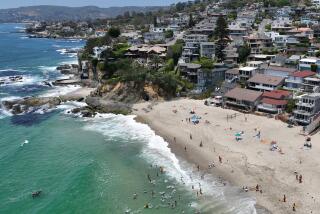Home of Elderly Touted as Hot Spot : Miami Beach Wants Piece of Spring-Break Action
- Share via
MIAMI BEACH — Miami Beach, where the good old days are good and gone, is now going after a share of the zany spring-break business that has long been the specialty of the Fort Lauderdale strip.
Promotional brochures are trying to lure college students with “Bloody Mary Madness . . . Affordable Rooms . . . Nonstop Action . . . The Only City That Allows You to Drink on the Beach.”
All of this seems a strange come-on from a place better known as home to grandma and grandpa. The 1980 census places the median age in the city at 67.8. Milk of Magnesia flows more freely than beer.
But local tourism officials hope that students have been watching enough “Miami Vice” to fancy this as a hip place of wild parties, fast cars and G-strings not much wider than dental floss.
“We’re selling them on the new mystique,” said Lucia Hausman of Penrod’s, a South Florida chain of bars that has been signed up to promote Miami Beach as the new wave in collegiate getaways.
On most days, however, even during the late-morning hours scheduled for “Bloody Mary madness,” the 15 blocks set aside for this coming spring revelry seem to dodder more than they boogie.
This area, known as South Beach, is the city’s most visible pocket of decay. It is largely a mix of inexpensive hotels and rundown apartment buildings.
Most of the residents are elderly. Many of the others are recent Cuban refugees.
“I just pass the time here, waiting for the last day,” said Rebecca Sugarman, a white-haired woman in her 80s sitting on a hotel porch.
Miami Beach officials have long wanted to revive this precious piece of real estate. Proposals have ranged from nudity on the beach to casino gambling to digging a lattice of canals for an imitation Venice. Landlords of some high-rises have offered so-called “yuppie discounts” to tenants under age 50.
The selling of spring break is another in the long string of schemes for luring new blood and new money to South Beach.
Two weeks ago, a brigade of 23 city officials, hoteliers and well-scrubbed young promoters went on a tour of campuses in the Northeast, carrying along 1,000 pounds of sand, four potted palm trees and this pitch:
Miami Beach is prepared to match the competition, beer for beer, tan for tan, decibel for decibel, party for party.
“We’d like everybody to take advantage of the fact that we want you desperately,” Les Feldman, a board member of the city tourism authority, told students in Boston.
Some were unconvinced. “My grandmother lives there, so I know it’s not a hopping place,” said Brandeis University student Steven Kipnis.
Others were outraged. Penrod’s offered free air fare and lodging as prizes to student newspaper editors who would write favorable stories about Miami Beach, a suggestion of an ethical breach that angered young journalists. “A pretty diabolical public-relations scam,” said Ian Fisher, editor of Boston University’s Daily Free Press.
But other students look kindly on any place that invites them to guzzle beer and flop on the sand.
“We’re getting tons of phone calls,” said Murray Gold, executive director of the Miami Beach Resort Hotel Assn. “Not so many reservations, but phone calls. I think it’s going to be a last-minute rush.”
If the rush comes, Fort Lauderdale--long the East Coast magnet for spring mayhem--won’t mind sharing the crowds.
Last year, more than 350,000 students--more than twice the city’s permanent population--overran Fort Lauderdale during the seven-week span of college spring vacations, from late February through early April.
“We had traffic jams, we had trash all over the beach,” Mayor Robert Dressler said.
The crowds may have been a bonanza for Fort Lauderdale bars, but it cost the city $750,000 to police the streets and clean up the mess, Dressler said.
This year, Fort Lauderdale for the first time is discouraging the student hordes. It is prohibiting open containers of alcoholic beverages on the beach and has built a concrete barricade to keep people from milling onto oceanfront Highway A1A.
“We would be delighted to share our blessings,” Dressler said with a lilt of sarcasm.
In Miami Beach, no one has much of an idea how many blessings are likely to come their way.
For now, the beachfront remains largely the special joy of the people who live in the old Art Deco hotels across from the ocean. Some are here to stay the winter, some to stay for good.
Women sit on lawn chairs knitting sweaters or tossing white bread to the pigeons. Men clutch the hands of their wives, the same hands they have held for half a century.
“Let the kids come, so long as they don’t make trouble,” said Alan Feldstein, 74, one of those men.
Then he mulled it over a bit more and his face became puzzled.
Here?” he asked. “They want to come here?”
Researcher Lorna Nones contributed to this story.
More to Read
Inside the business of entertainment
The Wide Shot brings you news, analysis and insights on everything from streaming wars to production — and what it all means for the future.
You may occasionally receive promotional content from the Los Angeles Times.










